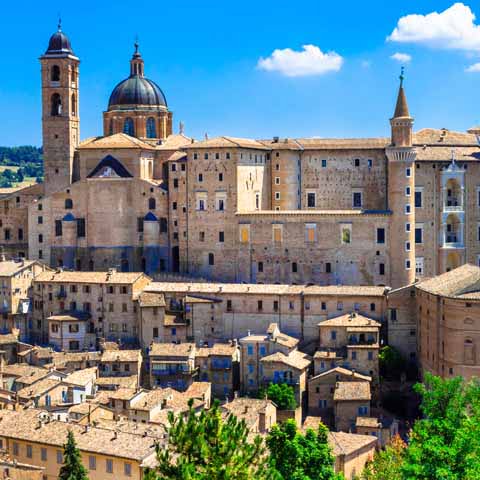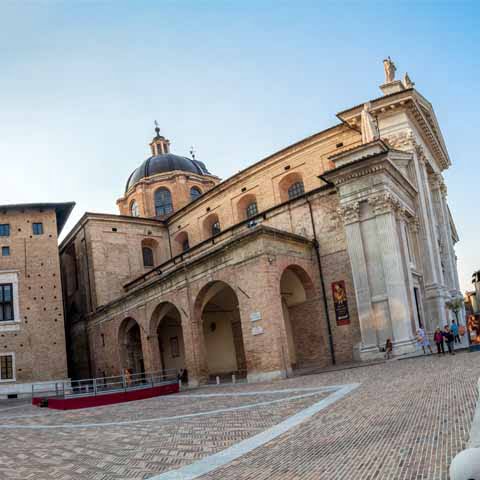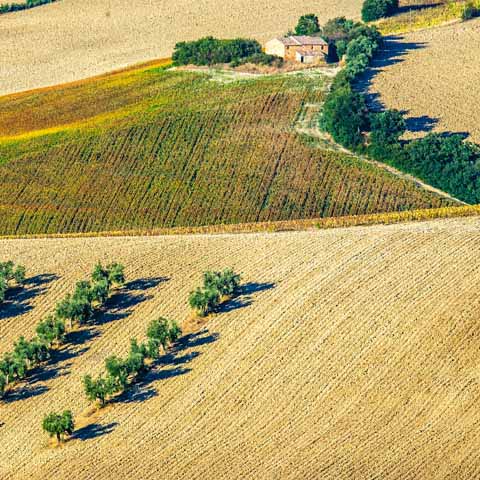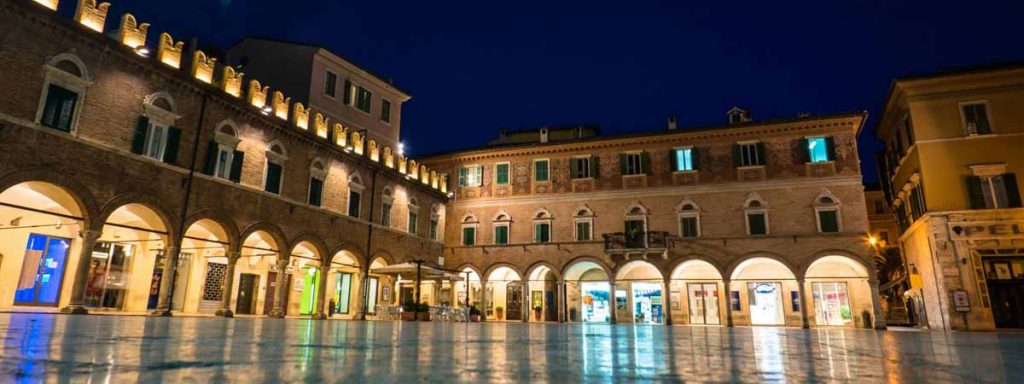If looking for classic Italy – historic buildings, artistic wonders, culture, and timeless beauty – look no further than Urbino. Set atop a tall hill, this hidden gem is characterized by its unique skyline, which is comprised of ancient Renaissance structures made of warm-toned brick. Despite the city’s bustling, modern student population at the University of Urbino, the city seems as if halted in time, which is fitting for a location whose glory days were rooted in the 1400s.
Urbino’s history dates to its founding during Roman times. Originally called Urbinum Metaurense, which means “City by the Metauro River,” the town would eventually come under the rule of the Montefeltro family. It was during the fifteenth century that Urbino truly made its mark in history. After 1626, the city would decline from its position as a powerhouse and transform into a small, hillside town known for its rich history and beautiful architecture.
Because the city flourished so much in the fifteenth century, it attracted a wide array of intellectuals, architects, and artists from all across Italy. Their marks are left all over Urbino, as the city is home to some of that time period’s most important art and structures. Urbino is known for its stunningly well-preserved Renaissance buildings. In fact, the city’s historic center has been designated a UNESCO World Heritage Site for its amazing brick buildings that depict the rich history of the area.
The other structures worth seeing in Urbino are the city’s Cathedral – known for its Neoclassical style and fine art, the House of Rafael – once the childhood home of the artist himself, the fourteenth century Church of San Domenico, and the grand Ducal Palace – the city’s largest and most awe-inspiring piece of Renaissance architecture.
The economy of Urbino is based mainly in tourism, however other aspects of the city’s economy include the University of Urbino and artisanal industries such as ceramics, weaving, embroidery, and art restoration.
The city’s population is about 14,000, but this nearly doubles during the school year due to the thousands of students who attend the city’s university, the University of Urbino.
Urbino can be a great jumping off point to explore other areas throughout the Marche region and the surrounding regions of Italy, but it is best experienced thoughtfully and fully – allowing oneself to truly immerse in the history and culture that has made it Marche’s best-known travel destination.
GEOGRAPHY & CLIMATE
Urbino is located in the Marche region of Central Italy. The geography of the area is characterized primarily by hills, as the city is located at the base of the Northern Apennine and Tuscan-Romagnolo Apennine Mountains.
One of the most unique aspects of the city’s geography is its seismic activity. Positioned in an area called Montefeltro, a location known for its medium to high risk of seismic activity, Urbino experienced nearly 65 seismic events between 1511 and 1998. Some of these seismic events ranked higher than VIII on the Mercalli scale, a measuring system that gauges the intensity of seismic activities.
The climate of Urbino is characterized by warm summers and winters that are quite cold. Throughout the year, average temperatures can range from 35°F in the winter to 83°F in the summer. The low temperature typically does not go below 28°F in the winter or above 91°F in the summer. For travelers hoping to enjoy outdoor activities, the best time to visit is between July and August.
WHEN IN URBINO
Admire the amazing Palazzo Ducale. A stunning testament to the nobility and artistry of Renaissance architecture, the Palazzo Ducale is Urbino’s most iconic site and one of Italy’s most important monuments. The palace is a UNESCO World Heritage Site and contains 27 rooms. Inside the palace, one of the most stunning rooms is Federico da Montefeltro’s studiolo, or small study, which is filled wall to wall with beautiful wood inlay artwork depicting books, scientific instruments, nature scenes, and much more.
The Palazzo Ducale is also home to the Galleria Nazionale delle Marche (National Museum of Marche) which contains a wide collection of paintings, sculptures, and other works of art including The Flagellation of Christ, a masterpiece by Piero della Francesca, as well as La Muta by Raphael, Resurrection by Titian, and Crucifixion by Luca Signorelli.
Visit Raphael’s house. Famed artist Raphael was born in Urbino in the late 1400s, and today’s travelers can visit the fifteenth century home where he grew up. Restored in 1875 by the Raphael Academy, the home features what is believed to be one of Raphael’s earliest paintings, as well as a few copies of Raphael’s works, a painting by Giovanni Santi (Raphael’s father and a painter of the Duke of Urbino’s court), and preserved items from the past. The architecture, culture, and history of the house are all worth experiencing.
See the Duomo di Urbino, or Urbino Cathedral. Dedicated to the Assumption of the Blessed Virgin Mary, the Urbino Cathedral was originally built in 1063, rebuilt in the fifteenth century, damaged by an earthquake in the eighteenth century, and then subsequently reconstructed with Neoclassical elements. It features a unique bright white façade that differentiates it from the surrounding buildings made of brick. It contains statues, paintings, and stunning interior details.
Enjoy delicious local food, wine, and cocktails at Urbino’s restaurants, bars, and cafés. From unique, local recipes to delicious classic Italian fare like gelato and pasta, the culinary scene in Urbino is lively and delicious.
Located in the Marche region of Central Italy, Urbino is a small hilltop town with a whimsical atmosphere. Thanks to the stunning Renaissance architecture that dominates the city center, a trip to Urbino is akin to stepping back in time.
Travel Guides



